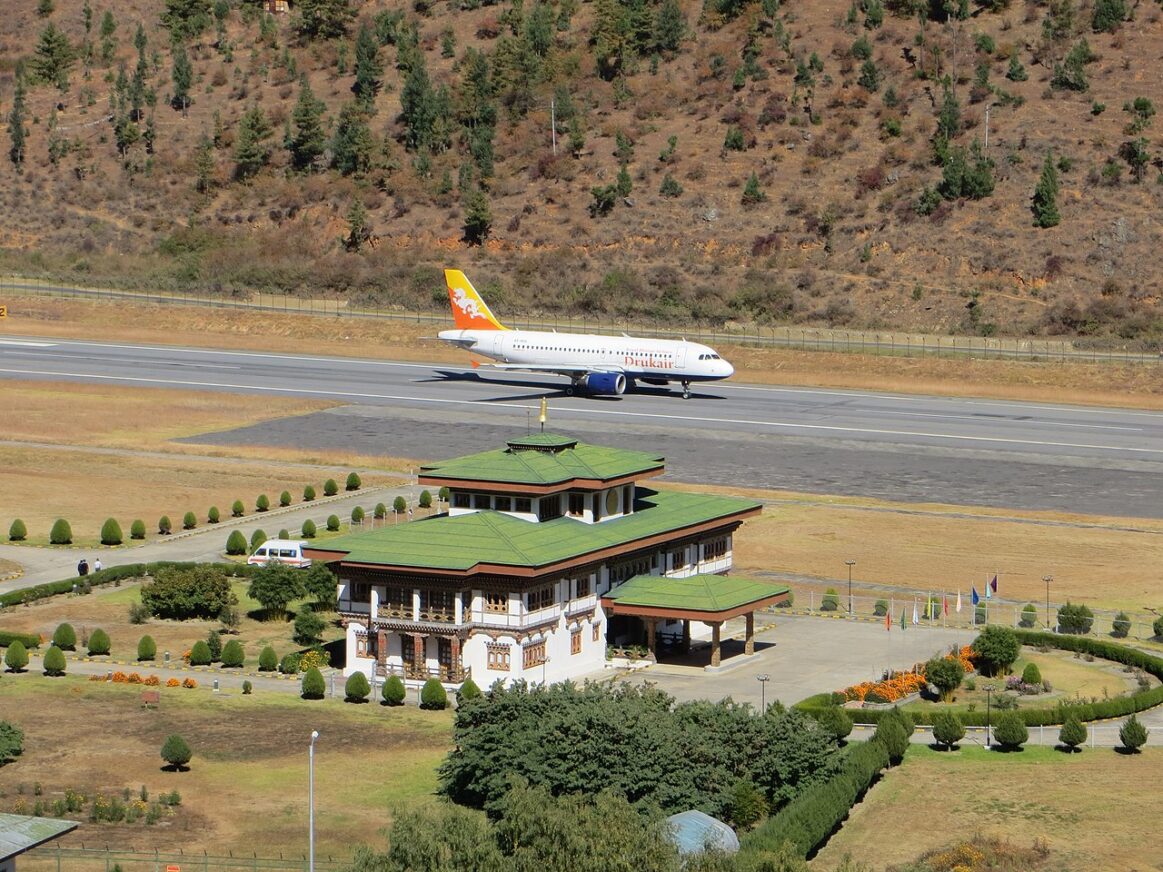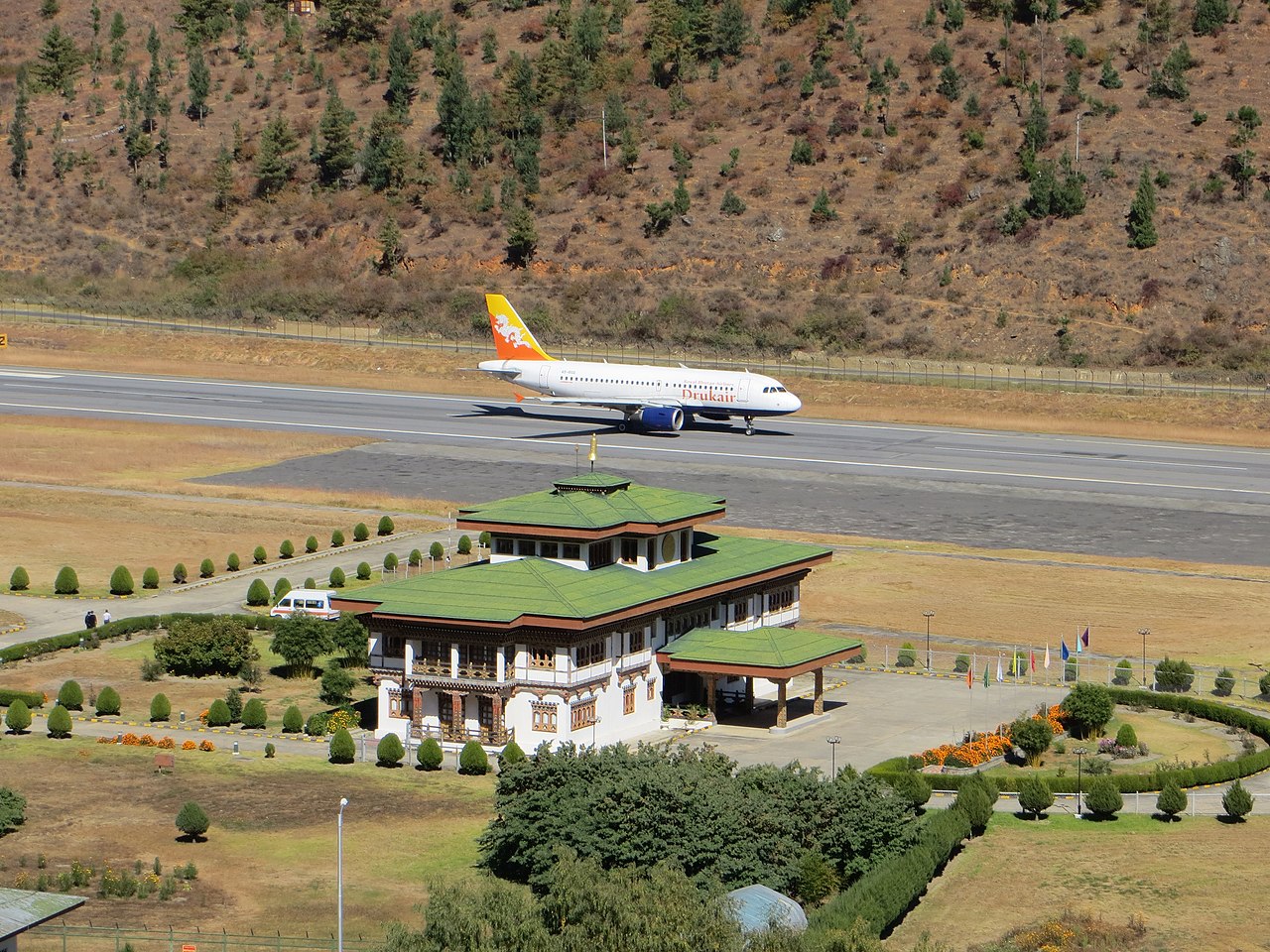Introduction
Nestled in the heart of Bhutan, Paro International Airport (IATA: PBH, ICAO: VQPR) stands as a singular marvel of engineering and natural beauty. As the sole international airport in Bhutan, it is the main gateway for travelers seeking to explore the rich culture and stunning landscapes of this Himalayan kingdom. The airport is situated just 6 kilometers from Paro town, along the banks of the Paro Chhu river, and is enveloped by towering peaks that soar to heights of 5,500 meters (18,000 feet). The airport’s strategic location, combined with its challenging landing conditions, makes it one of the most remarkable and intimidating airports in the world.

Geographical Context
Paro International Airport is uniquely positioned in a deep valley, surrounded by rugged mountains that create a breathtaking but daunting backdrop for aviation. The airport sits at an elevation of 2,235 meters (7,332 feet) above sea level. This altitude significantly impacts the aerodynamics of aircraft, requiring specialized training and experience for pilots to safely navigate the challenging terrain. The combination of high elevations and narrow valleys means that only a select group of pilots are certified to operate flights into and out of Paro.
Operational Limitations and Challenges
The operational constraints at Paro Airport are primarily due to its geographic features. Flights to and from the airport are allowed only under visual meteorological conditions (VMC), meaning that pilots must have clear visibility of the surrounding terrain and weather. This restriction limits flight operations to daylight hours, typically from sunrise to sunset. Moreover, during windy seasons, additional operational limitations are imposed in the afternoon, further complicating flight schedules.
The absence of advanced navigation technology at Paro International Airport adds to the challenges faced by pilots. Unlike many international airports equipped with Instrument Landing Systems (ILS), Paro relies on manual navigation methods. Pilots must rely on their experience and expertise to approach the airport’s short runway, which is just 2,265 meters (7,431 feet) long—approximately half the length of runways at major airports such as Singapore’s Changi Airport.
A Brief History of Paro Airport
The history of Paro International Airport dates back to 1968 when the Indian Border Roads Organisation constructed an airstrip in the Paro valley. Initially, this airstrip was used for helicopter operations by the Indian Armed Forces, facilitating logistical support for the Royal Government of Bhutan. It wasn’t until 1981 that Drukair, Bhutan’s national airline, was established by royal charter, marking a significant milestone in the country’s aviation history.
Drukair’s inaugural flight took place on February 11, 1983, connecting Paro with Kolkata, India. At that time, the airport comprised a basic infrastructure of a two-room air traffic control building and a departure lounge set up on the lawn. Over the years, Paro International Airport has undergone several expansions and upgrades to accommodate the increasing volume of air traffic.
In 1990, the runway was lengthened to 1,964 meters (6,445 feet) and reinforced to support heavier aircraft. This upgrade was crucial for attracting more airlines and increasing passenger capacity. The arrival of the BAe 146-100 in 1988 marked the beginning of jet services to Paro, with subsequent aircraft introductions expanding the airport’s operational capabilities.
PASSENGER FLOW
Facilities and Amenities
Paro International Airport features a single terminal building that was commissioned in 1999, with renovations and improvements made over the years. The interior of the airport has been revamped to showcase Bhutanese art and culture, providing travelers with a unique experience upon arrival or departure. Facilities at the airport include:
- Duty-Free Shop: Passengers can browse a selection of local handicrafts, souvenirs, and luxury items before departure.
- Cafeterias and Restaurants: The airport offers dining options where travelers can enjoy a taste of Bhutanese cuisine as well as international fare.
- VIP Lounge: A comfortable waiting area for VIPs and business travelers to relax before their flights.
- Bank and Post Office: Essential services for currency exchange and postal needs are available within the airport.
- Taxi Services: Ground transportation options are readily accessible for passengers looking to travel to Paro or Thimphu.
Airlines and Destinations
Paro International Airport serves as a hub for several airlines, including Drukair and Bhutan Airlines. The airport connects Bhutan with major cities in India, Thailand, and Bangladesh, among others.
Airlines Operating at Paro International Airport:
- Drukair: The national carrier offers flights to various destinations, including:
- Bagdogra
- Bangkok (Suvarnabhumi)
- Delhi
- Dhaka
- Dubai (International service begins October 28, 2024)
- Guwahati
- Jakar
- Kathmandu
- Kolkata
- Singapore
- Bhutan Airlines: This private airline also operates flights to several key destinations:
- Bangkok (Suvarnabhumi)
- Delhi
- Kathmandu
- Kolkata
- Seasonal flights to cities like Bangalore and Gaya.
AIRLINES OPERATING IN BHUTAN
DesignAirport Overview
A simple overview chart can summarize key statistics about Paro International Airport, including its elevation, runway length, and operational characteristics.
| Category | Details |
|---|---|
| Elevation | 2,235 meters (7,332 feet) |
| Runway Length | 2,265 meters (7,431 feet) |
| Airlines Operating | Drukair, Bhutan Airlines |
| Annual Passengers | Approximately 100,000 (2023) |
| Main Destinations | Delhi, Bangkok, Kolkata, Dhaka |
Seasonal and Charter Flights:
In addition to regular routes, Paro International Airport accommodates seasonal flights to popular tourist destinations and charter flights, making it a critical link for international travelers visiting Bhutan.
The Flight Experience
The experience of flying into Paro International Airport is as memorable as the destination itself. The approach involves navigating a winding valley, often with limited visibility due to weather conditions. As the aircraft descends, passengers are treated to stunning views of the Himalayan landscape, rice terraces, and traditional Bhutanese architecture.
However, the descent into Paro requires precision and skill. Pilots must manually fly the approach, adhering to specific altitudes and speeds while making critical decisions in real-time. The landing sequence typically involves a rapid descent followed by a swift turn to align with the runway, a maneuver that requires extensive training and experience.
Training and Certification for Pilots
Given the unique challenges posed by Paro International Airport, the certification process for pilots is rigorous. Only a select number of experienced pilots are qualified to land at the airport. Training involves a thorough understanding of the local geography, weather patterns, and manual flying techniques, as well as adherence to the operational limitations imposed by the airport’s design.
Pilot training programs typically include:
- Simulator Training: Pilots undergo extensive simulator sessions that replicate the challenging landing conditions at Paro.
- Mountain Flying Techniques: Understanding the intricacies of flying in mountainous terrain is crucial, requiring pilots to develop skills in navigation, altitude management, and emergency procedures.
- Continuous Education: Regular training updates ensure that pilots remain current with the latest aviation protocols and safety measures.
Traveling to Bhutan
Visitors to Bhutan typically arrive at Paro International Airport, where they are greeted by the rich culture and hospitality of the Bhutanese people. The airport serves as a gateway to a country steeped in tradition, where visitors can explore majestic monasteries, pristine landscapes, and vibrant local markets.
Visa Requirements:
Travelers to Bhutan must obtain a visa prior to arrival. The process is facilitated by licensed tour operators, ensuring that all necessary arrangements are made. Bhutan has a unique tourism policy that encourages sustainable travel, requiring visitors to book their trip through a local tour operator.
Best Times to Visit:
The ideal time to visit Bhutan is during the spring (March to May) and autumn (September to November) months when the weather is mild, and the landscapes are particularly vibrant. During these seasons, various festivals take place, providing visitors with a unique opportunity to immerse themselves in Bhutanese culture.
Conclusion
Paro International Airport is not just a point of entry into Bhutan; it is a testament to the country’s commitment to preserving its natural beauty while embracing the opportunities that come with international connectivity. The airport’s unique geographical challenges and operational restrictions create a distinctive experience for travelers and pilots alike. As Bhutan continues to grow in popularity as a travel destination, Paro International Airport will remain a crucial element of its tourism infrastructure, welcoming visitors to experience the unparalleled beauty and rich culture of the Land of the Thunder Dragon.
Future Developments
As Bhutan’s tourism industry continues to evolve, plans are in place to further enhance the infrastructure and facilities at Paro International Airport. These developments aim to improve passenger experiences, increase operational efficiency, and accommodate a growing number of flights.
Investments in technology and modern amenities will complement the airport’s rich cultural heritage, ensuring that it remains a vital gateway to one of the world’s most enchanting destinations.
Final Thoughts
In summary, Paro International Airport is a remarkable feat of engineering and an integral part of Bhutan’s identity. Its challenges and beauty encapsulate the spirit of a nation that values its environment and heritage. For anyone fortunate enough to fly into this stunning airport, the journey is not just about reaching a destination; it’s about embarking on an adventure filled with wonder, culture, and breathtaking landscapes.


